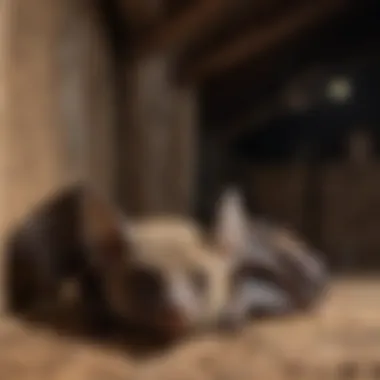Effective Strategies to Encourage Bats to Leave Hiding


Intro
Bats are intriguing creatures, yet their presence in homes can cause unease. Understanding them is crucial for humane and effective removal. This guide provides insights into bat behavior and practical strategies for encouraging them to leave. Homeowners often find bats in attics, basements, or wall spaces. Knowing how to deal with these situations, both safely for humans and gently for bats, is essential.
Understanding the Pest
Identification
Bats belong to the order Chiroptera. There are over 1,400 species worldwide, but in many residential areas, the most common include the Little Brown Bat and the Big Brown Bat. Recognizing these species is important. They are typically nocturnal, taking shelter in dark, enclosed spaces during the day. Their bodies are small, with the wings making them look larger in flight.
Life Cycle
Bats have a complex life cycle. They breed in late summer. After a gestation period of about two months, females give birth to one or two pups. These young bats are dependent on their mothers for at least a month. This reproductive cycle plays a role in their behavior. In the spring, bats often seek out warm spaces to roost while they wait for insects to become active in summer. Understanding their life cycle helps to comprehend their motives for nesting in a home.
Pest Prevention Strategies
Environment Modification
Preparing the environment is vital for keeping bats away. This involves correcting conditions around the home that may attract them. Remove sources of food, such as standing water or abundant insect populations, which can be found near dumpsters or lights that attract moths. Bats prefer areas with easy access to food and shelter. Fixing gaps or openings can discourage their return.
Physical Barriers
Another preventive measure is to install physical barriers. Screens on windows and vents are effective. Seal cracks and holes in roofs and siding with appropriate material such as metal flashing or heavy-duty mesh. This way, even if bats are nearby, they have lesser chances of entering your dwelling.
Control Methods
Chemical Control
Chemical solutions can sometimes be tempting. However, they are often not advisable for dealing with bats. Many chemicals can be harmful to bats and may not produce the desired effect. Instead, focus on humane removal methods that do not pose a risk to wildlife or violate laws protecting bats.
Biological Control
Biological control offers a different approach. Introducing natural predators or fostering ecosystems that deter bats may work in specific contexts. However, this strategy requires careful planning and consideration of local wildlife. It is imperative to maintain ecological balance and ensure the methods you choose are effective and ethical.
Understanding and respecting bat behavior is fundamental. Knowledge not only enhances safety but also supports wildlife conservation efforts.
Understanding Bat Behavior
Understanding bat behavior is crucial for those dealing with a bat hiding in their home or property. Bats are often misunderstood creatures, and knowledge about their habits can lead to effective and humane solutions. Recognizing why bats may choose to hide in your space sets the foundation for addressing any issues they cause. It is essential to grasp the intricate nature of their behavior, as this can inform how to encourage their safe removal.
Why Bats Hide
Bats hide for several reasons, primarily related to their natural instincts and environmental needs. First and foremost, bats seek refuge for safety. During the day, they are vulnerable to predators and unfavorable weather conditions. They often look for dark, secluded areas to roost, making attics, basements, and wall cavities attractive options. Additionally, bats are crepuscular creatures, meaning they are most active during twilight hours. This behavior drives them to seek out hiding spots where they can rest undisturbed until nightfall.
Food availability also influences bat hiding behavior. Many bat species consume insects, and their presence in residential areas often correlates with nearby food sources. When plentiful, they may choose to roost closer to these resources for easier access. Understanding these motivations can help homeowners identify potential solutions to encourage bats to vacate their hiding spots, as the environment plays a significant role.
Common Hiding Spots
Bats prefer specific locations that provide darkness, warmth, and security. Common hiding spots in homes include:


- Attics: These areas are often dark and undisturbed, making them ideal for roosting.
- Cavities in walls: Bats can easily enter small openings and find shelter within walls.
- Basements: This location offers a cool, dark place for bats to hide.
- Sheds and garages: These structures may provide similar benefits if they are not frequently disturbed.
- Under eaves or roof overhangs: External features of the building can also serve as potential roosts.
Recognizing these hiding spots can assist homeowners in addressing the issue before it escalates, allowing them to take appropriate actions without causing harm to the creatures.
Signs of Bat Infestation
Detecting the presence of bats is critical for assessment and intervention. Homeowners should watch for various signs that indicate an infestation:
- Droppings: Bat guano, or droppings, resemble mouse droppings but are often richer in color and may leave a white, powdery residue.
- Squeaking or chirping noises: Bats produce vocalizations, especially during the night when they are active.
- Odors: A musty smell often accompanies bat infestations, stemming from their urine and droppings.
- Scuff marks or stains: These marks can often be observed in areas of entry or exit, indicating frequent movement.
Paying attention to these signals not only helps identify an infestation but also guides the homeowners on when and how to act. By addressing the problem early, they can employ humane strategies to encourage bats to leave while reducing potential damage to their property.
Safety Considerations
When dealing with bats in residential areas, safety is a paramount concern. A thorough understanding of safety considerations not only protects homeowners and their families but also ensures the humane treatment of these creatures. Bats serve significant ecological functions, including insect control, yet their presence can raise legitimate concerns about health and legal implications.
Health Risks Associated with Bats
Bats can carry diseases that pose health risks to humans. One of the most notable concerns is rabies, a viral infection that can be transmitted through bites or scratches. Although not all bats are rabid, it is crucial to avoid direct contact. According to the Centers for Disease Control and Prevention (CDC), rabies can be fatal once symptoms appear.
Beyond rabies, bats can also transmit histoplasmosis, a respiratory disease caused by a fungus that grows in bat droppings. People who cleanup areas with bat feces or come into contact with contaminated surfaces can inhale spores, leading to potentially severe lung issues.
It's paramount that individuals ensure their living spaces are free from bat droppings and urine, as these can also harbor pathogens. Homeowner vigilance in maintaining cleanliness is key in mitigating possible health risks.
Legal Protections for Bats
In many regions, bats are protected under various wildlife conservation laws. For example, in the United States, some bat species are classified as endangered or threatened, making it illegal to harm or harass them. Homeowners must familiarize themselves with local regulations concerning bats.
Before attempting any removal methods, it is wise to consult with local wildlife authorities. Legal repercussions can arise from improperly handling bats, including fines and penalties. Thus, understanding these legal protections not only ensures compliance but also supports the preservation of bats and their habitats. Responsible actions towards wildlife can foster a healthier ecosystem and community.
Key Takeaway: Being aware of both health risks and legal protections is essential when dealing with bats in your home. Stay informed and approach the situation thoughtfully.
Methods to Encourage Bats to Leave
Encouraging bats to leave their hiding spots is a delicate process. It requires an understanding of their behavior and a thoughtful approach to safely guiding them outside. Effective strategies are critical. They not only assist in removing bats but also ensure their welfare and avoid unnecessary harm. Using methods that are humane is essential because bats play crucial roles in ecosystems, such as pest control and pollination. Here are some key methods homeowners can employ.
Creating an Uninviting Environment
To prompt bats to vacate, start by making their current location less appealing. Bats prefer dark, quiet areas, so significant disturbances can encourage their departure. Here are a few steps:
- Remove Bedding Materials: Bats often use accumulated debris as nesting material. Cleaning these spots may deter them.
- Increase Noise Levels: Sounds can disrupt their comfort. Using radios or sound machines to play continuous noise can induce discomfort and encourage them to relocate.
- Block Access to Hiding Spots: If you can identify where bats enter, consider temporarily blocking these entrances without trapping them inside.
By altering their environment, bats may feel motivated to seek out more suitable, quieter shelters.
Using Sound to Attract Attention
Sound can serve as an effective tool in encouraging bats to leave. Bats are sensitive to various frequency ranges, and utilizing these can help draw their attention:
- High-Frequency Sounds: Devices that emit high-frequency or ultrasound waves can disturb bats. These sounds can mimic their natural predators, promoting fear and prompting them to flee. However, ensure these devices do not harm the bats in any way.
- Playback of Disturbing Sounds: Playing sounds that mimic danger, such as the cries of predators, can guide bats out of hiding. Ensure the volume is kept at a moderate level to avoid stress.


These auditory cues might startle bats and cause them to seek refuge elsewhere.
Lighting Techniques and Their Effect
Lighting can also play a critical role in encouraging bats to leave their hiding spaces. Here are some methods:
- Bright Lights: Bats generally prefer dark spaces. Placement of bright lights in areas where bats roost can make them uncomfortable. Aim to direct the lighting so that it penetrates their hiding areas.
- Flashing Lights: Strobe lights or other intermittent light sources can be particularly disruptive. The changing light patterns may confuse or alarm bats.
By using lighting judiciously, it can significantly alter the habitat to make it less hospitable for bats, prompting them to leave.
The Role of Repellents
Natural and chemical repellents can influence bats’ choices and encourage them to vacate areas. Here are a few common choices:
- Essential Oils: Certain strong-smelling oils, like peppermint or eucalyptus, might repel bats. Spraying these around entry points can create an environment they dislike.
- Commercial Repellents: Some commercially available bat repellents are designed to deter bats without causing harm. These can be applied near roosting sites to encourage relocation.
Using repellents should be approached with caution, ensuring they do not harmful to bats or other wildlife.
Timing and Seasonal Considerations
Timing and seasonal factors play a pivotal role in how effectively one can encourage bats to emerge from hiding. Understanding these dynamics helps homeowners to devise strategies that align with the natural behavior of bats, enhancing the chances of success in safely prompting their departure.
Bats have specific periods during which they are more active, and these times can be influenced by various environmental factors, including temperature and food availability. Mistiming one’s efforts can lead to prolonged disturbances and unnecessary stress for both the homeowner and the bats involved. Recognizing the rhythm of bat activity not only ensures more efficient use of methods but also fosters a considerate approach to wildlife interactions.
Best Times to Encourage Emergence
The best times to coax a bat out of hiding depend largely on the local climate and bat species.
- Dusk and Dawn: Bats are primarily nocturnal. They tend to become more active just after dusk and prior to dawn. Attempting to encourage emergence during these twilight hours can yield better results. At these times, bats are likely to leave their hiding spots to forage for insects.
- Warmer Months: Spring and summer are ideal seasons for encouraging bats to leave. As the weather warms, bats are more inclined to exit their roosts.
- Quiet Periods: Minimizing noise and disturbances during these times can further promote an inviting atmosphere for bats to emerge.
By strategically targeting these periods, homeowners can create an environment where bats feel safe to leave.
Seasonal Bat Behavior Patterns
Bats exhibit distinct behavior patterns that vary with the seasons. Understanding these patterns is crucial for developing effective strategies for their removal.
- Spring: In many regions, bats wake from hibernation as temperatures rise. This is the time they seek out suitable roosting spaces.
- Summer: During this season, bats are actively foraging for insects, making them more likely to be seen. They often leave their roosts at dusk, signifying their hunting hours. Keep in mind, though, that young bats are typically learning to fly during this period, making it essential to be cautious about disturbances.
- Fall: As temperatures drop, bats prepare for migration or hibernation. They may relocate to more sheltered areas, making it a suitable time for homeowners to implement removal strategies.
- Winter: Most bats hibernate in colder months. Encouraging emergence at this time is generally ineffective. Attempting removal during the depth of winter can lead to unnecessary stress and harm to the colony, which is why it is essential to plan removal efforts in line with their natural cycles.
- Homeowners might notice an increase in activity around this time.
Being attuned to these seasonal behaviors not only promotes responsible management practices but also aids in ensuring the welfare of these vital creatures.
Alternative Solutions
In dealing with bats that have taken residence in your space, considering alternative solutions is pivotal. Approaching the situation with humane and effective methods is crucial for both personal safety and the welfare of the bats. These alternatives open avenues for responsible action, reducing human-bat conflict while promoting coexistence.
Professional Wildlife Removal Services
When it comes to bat concerns, enlisting professional wildlife removal services can be an effective route. These experts possess the training and experience to handle bats safely and efficiently. They also ensure that no harm comes to the animals while addressing the underlying issues leading to their presence in your home.


Professional services typically begin with an assessment. They inspect your property, identifying potential entry points and areas where bats are likely roosting. Following the evaluation, they will discuss tailored strategies for removal based on the particular species involved and the extent of the infestation. Furthermore, these professionals are often well-versed in local laws regarding bat conservation. This knowledge ensures they implement removal techniques that are legally compliant and ethical.
Another key benefit of hiring professionals is the additional layer of safety. Umcovered bats can carry diseases, and handling them involves risks. By relying on trained personnel, you minimize these hazards. They can also offer advice on preventing future occurrences, which is essential for maintaining a bat-free environment in the long term.
Building Bat Houses
Constructing bat houses emerges as a proactive and beneficial alternative solution. Instead of merely focusing on removal, providing bats with designated homes can redirect them away from residential spaces. Bat houses create a sanctuary for these creatures while promoting natural pest control. Bats are known to consume large amounts of insects, making them valuable allies in keeping pests at bay.
Building a bat house is straightforward. High-quality materials, such as untreated wood, are ideal as they prolong the life of the structure. The design should allow for proper ventilation and drainage, ensuring the bats are comfortable. It is also essential to place bat houses away from human activity, ideally 10-15 feet high, in spots with ample sunlight and protection from strong winds.
However, it's important to note that patience is required. It may take time for bats to discover and occupy the newly built houses. The waiting period is, therefore, an investment in wildlife conservation and balance with nature.
Preventing Future Bat Problems
Preventing future bat problems should be a primary focus for any homeowner. It is not enough to simply address a current bat issue; proactive measures are essential to ensure that these creatures do not return. Bats, despite their ecological benefits, can cause health risks and property damage. Taking preventative action safeguards both your living space and the bats themselves.
Sealing Entry Points
One of the most effective ways to prevent bats from entering your home is sealing all possible entry points. Bats can squeeze through surprisingly small openings. Common entry points include gaps in walls, around windows, vents, and under eaves.
- Inspection: Conduct a thorough inspection of your home’s exterior. Look for cracks, openings, or any signs of wear.
- Materials Needed: Use materials like mortar, mesh wire, or caulk to seal these entryways. Make sure that these materials are durable enough to withstand environmental factors.
- Timing: Seal entry points ideally in late fall when bats are least likely to be present, ensuring they do not get trapped inside.
Sealing entry points not only discourages bats but also enhances energy efficiency in your home.
Maintaining Bat-Free Environments
Creating and maintaining a bat-free environment requires ongoing effort. This goes beyond physical barriers; it includes ensuring that the areas around your home do not provide the attractions or resources that bats seek.
- Eliminate Food Sources: Bats are often drawn to places with ample insects. Implement pest control around your property to reduce the insect population.
- Remove Clutter: Keep your yard clear of clutter where bats might roost. Trim overgrown vegetation and remove any debris from your garden or yard.
- Outdoor Lighting: Installing motion-activated lights can deter bats by making their preferred roosting areas less appealing.
- Educate Yourself: Understanding bat behavior can also help. Bats are nocturnal and prefer places that are dark and quiet. If your home has inviting roosting conditions, they are more likely to return.
"Taking steps now can prevent the hassle of future bat issues and contribute to a more harmonious living condition for all involved."
By attending to these aspects, not only do you lessen the likelihood of a future infestation, but also contribute positively to the local ecosystem by understanding the role of bats in nature. You can protect your home while allowing bats to thrive elsewhere.
Finale
In summing up the key elements discussed in this article, understanding how to encourage bats to leave their hiding spots is essential for both homeowners and bat conservation. The delicate balance required to manage bats effectively necessitates a blend of knowledge about their behavior and appropriate methods to persuade them to exit safely and humanely.
Furthermore, the strategies outlined here provide practical and actionable steps that can be employed to promote safer cohabitation with these creatures. Not only does this address potential health risks associated with bats, but it also fosters an environment where they can thrive outside our living spaces.
Changes in environment, sound, lighting, and spatial use are important components that should be considered. Each method serves its purpose and can work synergistically to encourage bats to vacate without causing them harm.
Recap of Key Strategies
To effectively lure bats out of hiding, here are the primary strategies discussed:
- Creating an Uninviting Environment: By removing food sources and altering nesting areas within the home, bats find fewer reasons to stay.
- Using Sound Devices: Specific sound frequencies can disrupt bats, prompting them to vacate.
- Lighting Considerations: Bright lights can be an effective deterrent, as bats prefer darkened spaces for roosting.
- Employing Repellents: Special non-toxic repellents can provide additional assistance in encouraging bats to leave.
These strategies connect effectively to both human safety and ecological balance by ensuring that any removals do not unduly harm the bat population.
The Importance of Humane Methods
Maintaining a humane approach in bat removal is crucial for several reasons:
- Ethical Responsibilities: As stewards of the environment, it is vital to treat wildlife with respect. Bats play a key role in ecosystems and their removal should not lead to unnecessary suffering.
- Legal Protections: Many bat species are protected under various environmental laws. Knowledge of these regulations can guide appropriate methods to resolve bat-related issues.
- Long-term Solutions: Humane methods help prevent bats from returning through exclusion rather than harm, ensuring a lasting resolution without affecting the bat population negatively.
By implementing humane strategies, homeowners not only mitigate immediate concerns but also support the natural world. This comprehensive understanding ultimately contributes to a sustainable coexistence.







